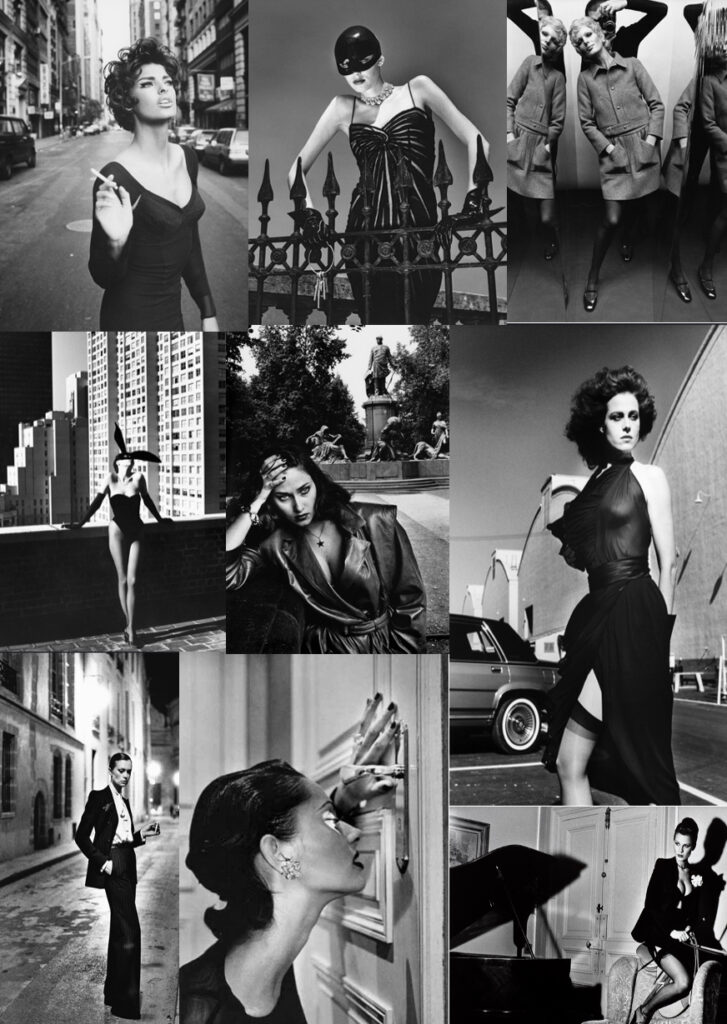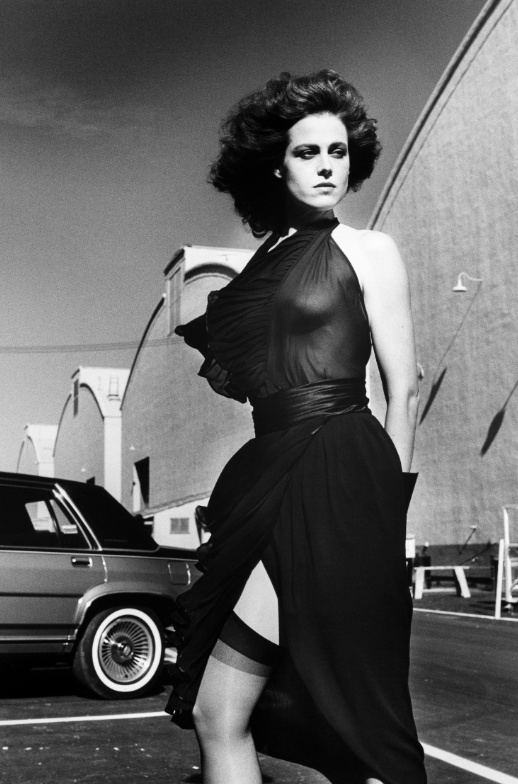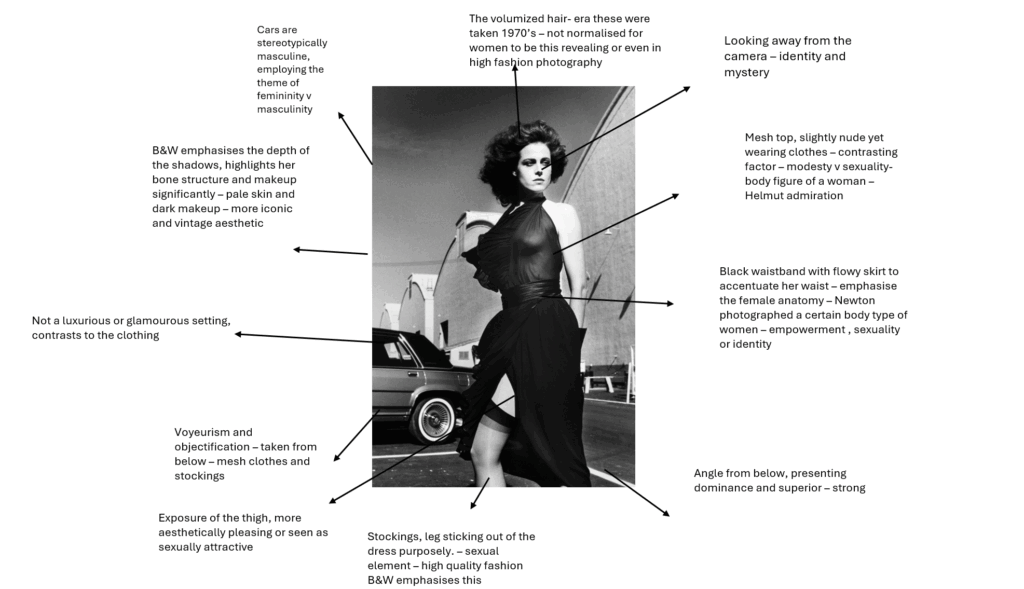Who is he?
Helmut Newton was a German-Australian photographer. The New York Times described him as a “prolific, widely imitated fashion photographer whose provocative, erotically charged black-and-white photos were a mainstay of Vogue and other publications.”

From the 1970s, Newton regularly used Polaroid Instant cameras and film to get an immediate visualisation of composition and lighting, especially for his fashion photography. By his own admission, for the shoot of the “Naked and Dressed” series that started in 1981 for the Italian and French Vogue, he used Polaroid film “by the crate”. The Polaroids also served as a sketchbook, in which he scribbled notes with regard to the model, client, location and date. In 1992, Newton published Pola Woman, a book consisting only of his Polaroids. Over 300 works based on the original Polaroids were shown at 2011 exhibition, “Helmut Newton Polaroids”, at the Museum für Fotografie in Berlin.
Moodboard

What was he known for?
His work often featured confident, bold, strong women with cinematic poses, combining glamorized elements to raw sensuality through nudity. Newton’s fashion photography explored themes of power, desire and voyeurism. He did this through mostly taking images of women, some what revealing, which feminist critics such as Lauren Mulvey may not see as feminine in a positive perspective. This differs to my personal study project on stereotypes as I am switching my photo shoot for women to have more power and confidence through their bodies and identity, however this may not be seen as positive as some may find his work over- sexualizing and objectifying. To contrast this raw and revealing element to his photographs, he significantly uses glamour clothing and luxurious settings. He executes this so well, that his images almost look surreal and movie-like, adding the theme of cinema and film (similarly to Cindy Sherman).
What did feminist critics feel about his work?
Feminist critics have mixed opinions about his work as Newton’s images often portrayed women as submissive, objectified or over sexualized. Some feminist critics argued the traditional gender roles and stereotypes and a male gaze, linking to my previous project surrounding the theme of how stereotypes are formed. Some critics saw his photography as a sense of voyeurism, and women were framed as objects of desire, often in provocative, passive and submissive roles. They argued that his images expressed an imbalance of power between men and women and argued the idea of women’s bodies as objects for male pleasure. However, there were also some feminist voices that argued Newton’s work argued conventional aspects of feminist by portraying women in powerful, confident and unapologetic ways. While these images may be sexually suggestive, they could also be seen as offering women autonomy and power which was ultimately rare in the mainstream fashion photography during the 1980’s. Personally, I see his work as more worshipping and admiring the female body, and expressing this through his art and photography. I think this as he matches his sexual and nudity elements to a luxurious setting, potentially portraying how women should be treated and have more power. In my opinion, his style of posing these women and dressing them gives the women a sense of confidence and power. This inspires me as I want my project around the theme of ‘union’ to be differing from my previous personal study with a link to it. Therefore, this study instead of showing society’s expectations and formed stereotypes, I wish to express the rebelling, confident and bold aspect which was not society’s standards or expectations in the 1980s. Meaning, I want to express the same theme however from a different perspective and angle.
How does his work link to ‘union’
Helmut Newton’s work links to theme of union in a feminist, political and historical way. Personally, I think Newton used women in his images sexually as he admired and saw the potential of power, women can hold. Newton frequently used women, and not men, expressing that he admired the female body and identity and wished to reinforce this especially considering this was rare in the main-stream fashion in the1980’s. I believe this through depicting women in strong, assertive poses challenging traditional gender roles, which women wanted to change their dynamic and Newton pushed this vision. He is linked to this theme through his portrayal of power dynamics, sensuality and the interplay between individuals in his iconic fashion photography. The subjects are portrayed as both vulnerable and dominance, expressing a union of oppositional qualities women have. This dynamic explores different aspects such as strength and sensuality can coexist and form a powerful identity, which I believe was Newton’s vision.
Why did I chose Newton?
I chose to study Newton as he differed from societal expectations. I believe that he saw the potential in women during the 1980’s and ultimately photographed women through admiration. This is because of how he dressed the women, how the women posed and the luxurious and glamour settings. The posing often obtained an element of power and resilience with a sexual element. He had a significant impact on fashion photography due to the rare appearance women had in the main stream photography. Although his images held a sense of voyeurism, the women were portrayed to hold power and be more dominant. Newton purposely positioned them in ways, where they were not seen as vulnerable but instead powerful. His work differed from the traditional stereotypes significantly. This beneficial for my project as my previous personal study, surrounded the theme of traditional stereotypes and argued how they are formed. Newton challenges this as he reinforced the idea of changing the typical stereotype of a women being seen as weak and vulnerable. Therefore, I aim to differ to my previous project by executing the opposite. Next, I will attempt to show a rebellious aspect and show what women wish to be, and how they have changed through the years, rather than be what men wish women to be such as the ‘traditional housewife’ and instead emphasize individuality and chosen identity.
Helmut’s photography expresses an element of sexuality, identity, beauty and societal norms. His work links to the second wave feminism. Second-wave feminism was a period of feminist activity that began in the early 1960s and lasted roughly two decades, ending with the feminist sex wars in the early 1980s and being replaced by third-wave feminism in the early 1990s. This links to Newton’s work as his images were in the 80’s. I believe his work focused on the theme of women empowerment. However, Newton’s work could of emphasized beauty standards as his women are often the same size, same body type and are seen as conventionally attractive. This provoked backlash. His recurring use of a singular, idealised body type and his portrayal of women often raised concerns about the representation of women in media and the reinforcement of unrealistic beaut standards. His work and objectified figures often fitted a very narrow standard of beauty. This lead to critics to argue that his photographs contributed to the pressure on women to conform to an unattainable body type. This could have set women empowerment and resilience back, as women feel a certain pressure on them to meet these standards. However, overall I believe he reconstructed the stereotype of women as strong, dominant and assertive. This ultimately shows an element of equality.
Context
Newtons career started during the aftermath of WW2, leading into the sexual liberation movements of the 1960’s and 1970’s and the Cold War and gender dynamics. This era saw significant changes in beliefs towards sexuality, gender roles and women’s autonomy. Newton’s photography can be seen as a commentary on the ever changing dynamics of sexual expression during this time. His work expresses the shift from conservative, repressed sexual elements to a more open and expressed liberated exploration of sexuality. However, his over sexualizing and submissive figures can be argued that they are a step that reinforced patriarchal values. This is because it challenges the idea surrounding whether women were only seen as a desire for pleasure or voyeurism.
Newton’s work often tied to the concept of the “ male gaze”, a term created by the feminist film theorist Laura Mulvey. This is when women are often depicted in the media as objects of male desire and control. He does this through passive and submissive poses. This links to the historical roots of classical art, where women were often depicted as idealised, passive and sexually available figures. Newton’s work challenges this historical representation as reinforces the traditional narratives of male dominance in its visual culture.
Helmut’s consistent use of slender, tall and conventionally attractive women in his photography can be tied to the historical idealization of a particular body type in the Western culture. In the 20th century, the ‘ ideal’ body type was slim and youthful, reflecting larger cultural values. While this representation aligned with historical values about beauty, it also stood in contrast to the increasing awareness and critique of body diversity. This beauty concept reinforced harmful and unrealistic standards for women.
Historically, eroticism in art has fluctuated between periods of taboo and periods of celebration, reflecting societal changes. In the early 20th century, avant-garde movements like Surrealism explored the sexualised female body, linking to themes of power, mystery and desire. Newtons work can be seen as avant-garde exploration, where the boundary between eroticism and high art became blurred in the 1960’s and 70s. By integrating erotic themed into high-fashion photography, Newton aligned with a broader historical trend of pushing the boundaries of traditional art, even as his work was criticized for reinforcing certain regressive gender roles and dynamics.
Image Analysis

I have decided to analyse this images as it holds many contributes that stood out to me. The first thing that drew my attention was the mesh top. As shown, she is slightly nude and revealing yet still wearing clothes to contrast to this. This creates the element of modesty vs sexuality. It is showing the body figures of a woman, which I believe Newton admired and made them feel valued. This aspect is significant as it is probably the first noticeable and significant thing of this image. The way the camera is angled, from slightly below with the subject slightly turning away to the right, creates an element of mystery and potentially identity. But mostly, this brings in a sexual aspect which feminists critic as women were seen for desire for males pleasure. This creates the debate of voyeurism and the right intentions behind it. Next, this is emphasised by the subjects clothing, specifically the stockings. Newton made this evidently shown significantly through the subject’s leg sticking out of a slit of a skirt. This again, adds to the sexual theme which Newton frequently portrays. In black and white, this does make it stand out as her skin is white contrasting with her black clothing, making the stockings hard to miss. These may include the perception that stockings, and the associated use of garters, lace, high fashion, appliqué and the exposure of the thigh, are more aesthetically pleasing, or sexually attractive. Newton was known for high-fashion photography, therefore the stockings contributed to this style of his. The black waist band in contrast to the flowy skirt, accentuates her waist emphasising the female body figure and anatomy. This may have been purposeful to show women empowerment, sexuality and even identity. The low image could be to symbolize women in more dominant place, rather than being submissive and it revolving around men. Her volumized hair, links to the era these images were taken, in the 1970’s. This links to how all his images are in black and white to maintain a vintage and iconic aesthetic. Not only this, but the black and white demonstrates the subjects pale skin and dark makeup and clothing, emphasises the depth of the shadows. This depth within shadows, shows her bone structure and cheek bones. Making the awareness of the theme of femininity more portrayed. Lastly, one thing that differs this image to most of his images is that it is not in a luxurious setting and is in public. This contrasts to the medium’s clothing as her clothing is perceived as glamour. The background is rather grey, making the subject more focused. Potentially, the car could be significant as cars are stereotypically for men. This could be contrasting femininity vs masculinity and bringing into play the theme of gender roles.

How Yayoi Kusuma and Helmut link?
While both are working in different mediums and addressing different themes, they both share some connects through the exploration of identity, the body and sexuality, as well as their challenging conventional societal norms. Both focus on the human body, though in different ways. Newton is known for his eroticized and often objectified images of women’s bodies, which demonstrate the theme of power dynamics, sexuality and beauty standards. His images are frequently powerful and sexualised, yet his choice and style of poses emphasize submission or even dominance. In contrast, Kusumas work, explores the body as a site of transformation and obsession. Kusuma uses her own body in her art frequently painting herself with polka dots. This is to create the theme of self-erasure, individuality and blending her presence into her environment.
Through sexuality and gender, both artists engage with this theme significantly. Newton does this by, admiring and portraying the female body. However, his work can be seen as reinforcing traditional ideas of gender and power dynamics, especially through the lens of Laura Mulvey’s term the “male gaze”.Kusuma, on the other hand, subverts conventional ideas of sexuality and gender. She uses her art to explore the idea of sexual liberation. Her work is less conventional about beauty, desirability and the loss of self. Both artists received controversial reactions and feminist critiques.
Both artists used a sense of self representation, both Newton and Kusuma used their selves as subjects in their work, although in very different ways. Newtons work, especially in his personal photography, often placed him at the centre of the narrative, positioning himself as the creator and the voyeur. Kusuma on the other hand, used her own image to dissolve boundaries between herself and her art work. Her self-representation wasn’t about glorifying herself as a sexual object or celebrity, but about exploring the use of identity and the unity between the individual and the universe.
